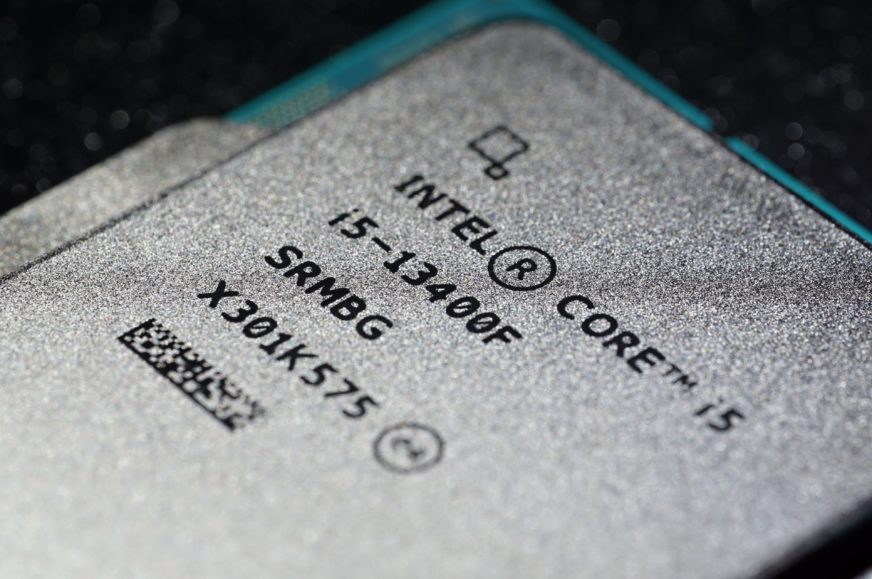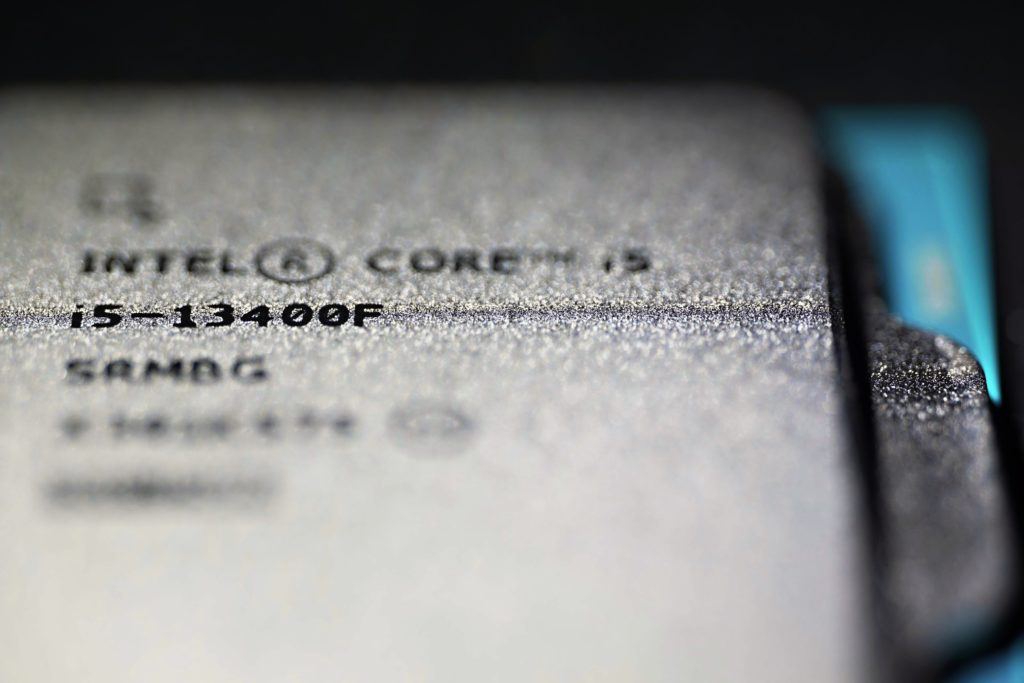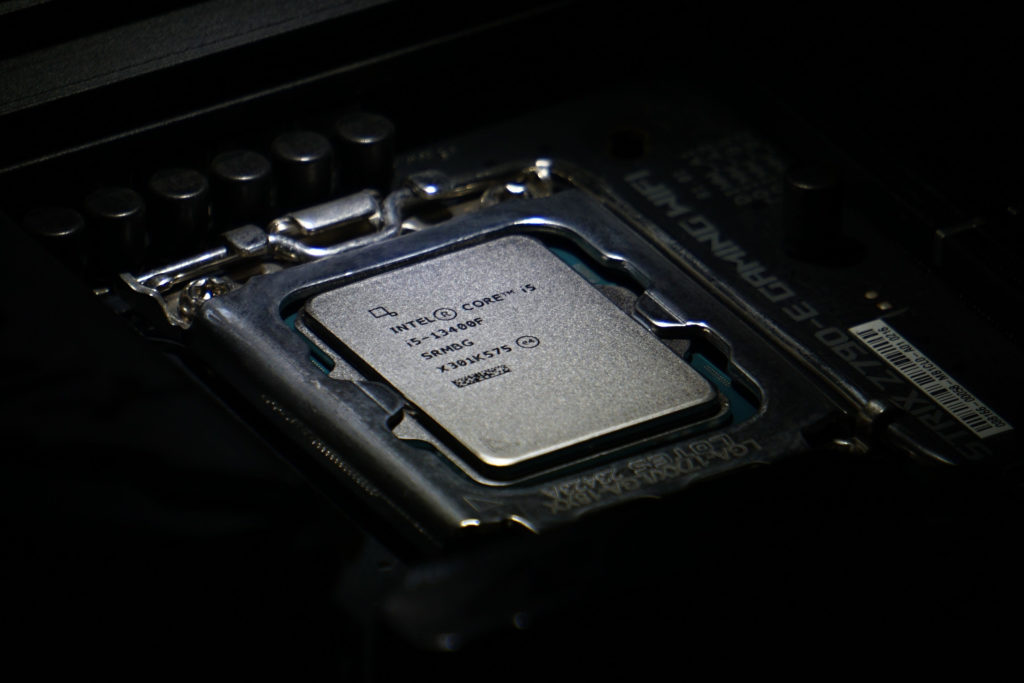Intel Core i5-13400F without E cores
With the little (E) cores turned off, the Core i5-13400(F) becomes a 6-core processor with 12 threads in the same way that the older Core i5-12400(F) is. This intergenerational comparison is also a side product of tests main goal of which is to show the impact of E cores not only on computational and gaming performance, but also on operational characteristics. The biggest differences occur in the situations that mainstream PCs run into most often.
The level of benefit of Intel processors’ E cores with the big.LITTLE concept is a subject of frequent debate and controversy. In the Raptor Lake generation, small cores concern even the lowest models of the Core i5 class, which compared to their predecessor Core i5-12400(F) achieve significantly higher computational performance precisely because of the fact that they already have one cluster with E cores active. Core i5-13400F is no longer “only” a 6-core processors, but a 10-core one. However, the basis in the form of six P cores is the same as in Alder Lake. In the case of some variants (stepping C0), as you already know, an identical die with native 8 P and 8 E cores is even used. Others (Core i5-13400/F, stepping B0) are based on a larger die, which have 8 more E cores. We have already published a more detailed analysis of this. We will now focus on two other things:
- How E cores affect the Core i5-13400(F)’s computational (and “gaming”) performance and operating characteristics
- What is the practical difference of the Core i5-13400(F) versus the Core i5-12400(F), as long as there are only 6 P cores active in 12 threads – i.e. the same composition across generations. For this analysis, we will also make use of test results of the Core i5-12400 in different steppings (C0 and H0), where H0 is a variant with the little die that does not physically contain E cores (it only has 6 P cores) and C0 is based on the bigger, 16-core die. Just as a reminder. For details, see the article The same and yet different. Intel Core i5-12400 duel (H0 vs. C0)
Consider the tests in this article as just a sort of “baseline”, to be followed up later by going through the full gaming tests you’re used to from the standard CPU tests. For now, we will focus only on a selection of those tests in which, in addition to processor speed, we also monitor temperature, achieved clock speeds and power draw. The latter is measured with current clamps directly on the power cables. Thus, these are not distorted measurements by the rest of the components in the build, but only the net CPU power draw, which is only slightly affected by some power inefficiency of the VRM. However, we always use significantly over-dimensioned motherboards so that these external distortions are negligible, and especially for each processor (and across platforms) to a comparable degree.
What components we use, how we methodically approach the measurements of individual electrical and non-electrical quantities can be found in this chapter of this article and in the chapters that follow it.
Test results – 6+4 vs. 6 cores…
All charts with results can be found in Chapters 2 to 7, from which we draw conclusions in the following text.
To the first point, the comparison of the Core i5-13400(F) features in the complete configuration (i.e. with 6 P and 4 E cores) and in the configuration with only 6 P cores. The multi-threaded performance difference is very significant, up to 27% with active E cores with a 20% increase in power draw. If we convert this into efficiency, or a kind of efficiency ratio (ratio of computing power per unit of power draw), it is higher as long as E cores are used. Naturally, this comes at the cost of an increase in power draw, but it doesn’t drive the processor into inefficiency, on the contrary.So when Intel refers to E cores as “efficient” cores, everything agrees.
When it comes to gaming performance in the three titles tested (F1 2020, Shadow of the Tomb Raider and Total War Saga: Troy), the activity of the E cores doesn’t have much of an impact. In F1 2020 and TWST, the results are virtually identical and the biggest difference is in SOTTR. The difference in average fps is again negligible, but the drop in minimum fps after turning off E cores is already 10%. The latter can be attributed to the fact that a task that runs on a fully enabled processor on little cores and doesn’t need high performance, now reduces performance on P cores by leaps and bounds. We will release a more comprehensive impact of E cores on Core i5-13400F gaming performance later, as we announced. This is just sort of the first shot, from which the power draw analysis is most attractive.
The difference in power draw is always greater than the difference in gaming performance. The latter is minimal (around 1–2% on average), as mentioned above. However, without E cores, the processor is always more efficient and its power draw is at least 6% lower in some games (Shadow of the Tomb Raider), or even up to 16% lower in F1 2020.
And now to the really dramatic differences. Without E cores, the power draw of the Core i5-13400(F) is as much as 10 times higher. Yes, 10 times. Instead of a very pleasant 1.9 W, it’s up to the level of 17.8 W – between Core i5-12400 stepping C0 and Core i5-12400 stepping H0. This is probably because the operating system overhead can no longer run on low-power E cores and P cores require more aggressive power supply, and the whole operation is already quite inefficient compared to an optimal state.
Weaker efficiency is also the case for single-threaded performance, where power draw without E cores is significantly higher for the same reasons, and even at lower computational performance.If only P cores are enabled, the processor does not hold the multiplier of 46 on the key cores so steadily, but here and there during the test it drops to 41 (i.e. to the level of all-core boost), at which point it loses time. Minimally, but still, and we can conclude that shutting down the E cores has a negative impact even for running single-threaded tasks. This is both in terms of computing performance and in terms of power efficiency, which is almost half of it with only P cores.
… 6 vs. 6 cores (Raptor vs. Alder Lake)
And how does it compare between generations if the Ci5-13400F processor is limited to 6 P cores? Computing and gaming performance is always a bit higher for Raptor Lake, equivalent to higher clock speeds. At all-core boost and in games it’s 100 MHz and in single-core it’s 250 MHz on average (in favor of the Ci5-13400/F). In a multi-threaded load, the increase is 3%, single-threaded up to 5%.
The power draw of the Core i5-13400F on 6 P cores is virtually identical to the Core i5-12400(F) stepping H0 under high load (Cinebench R23). And in fact the efficiency as well, the differences in computational performance are minimal.
Efficiency in games is also similar with exceptions (SOTTR, where the Core i5-13400/F is a significantly more efficient processor). That is, if you compare a Core i5-13400(F), regardless of stepping (B0/C0), to a Core i5-12400(F) stepping H0 (i.e. one with a little die that only has 6 P cores on the PCB). The power draw of stepping C0 (with the Ci5-12400/F) is higher, and as the load decreases, its efficiency decreases compared not only to stepping H0, but also to all Core i5-13400Fs.
The difference while idle (1.9 vs. 25.5 W) is truly abysmal. If the E cores work really well somewhere with respect to efficiency, it is at minimum load. In this respect, even chiplet Ryzens, whose efficiency is degraded mainly by the presence and activity of the I/O die, cannot compete with Intel.
English translation and edit by Jozef Dudáš
- Contents
- Intel Core i5-13400F without E cores
- Performance tests
- Memory and cache tests
- CPU power draw curve
- Average CPU power draw
- Achieved CPU clock speeds
- CPU temperature












Very interesting as always. Although only a preliminary assessment, it’s definitely a thing to throw in “E Cores useless for gaming” debates. 2W on idle is just crazy efficient, and a big argument for people who spend a lot of time browsing, coding, afking, and so on.
I cannot believe that the idle power of 2w vs 20W is just because of E-cores take care of all the background tasks. 13100f seems to idle at ~2W as well (w/o any E-cores), while, e.g. 13700k (with plenty of E-cores) idles at ~17W.
I understand that this seems unlikely to you, especially after the deduction you make regarding other processors.
Yes, you’re thinking correctly, that Core i3-13100F doesn’t fit the low power draw theory thanks to the E cores. However, it’s good to note that the Core i3 is the only processor of the Raptor Lake generation built on a H0 die. When you look at a comparison of Core i5-12400 steppings, you’ll see that the biggest difference in power draw is in idle, where stepping H0 is significantly more low-power. It doesn’t drop to 2W, but the difference in power draw is very significant, and there is clearly potential to further reduce it in newer processors by tuning the aggressiveness of the power supply. Even more so when it has two less active cores. Core i5-13400F in the two cases use different dies that behave differently.
It is true that the same die is also used by Core i7-13700K, but this processor does not reduce the multiplier to 4 (as Core i5-13400F), the minimum is 8 (800 MHz) and higher clock speed requires more aggressive power supply. Certainly, compared to the Core i7-13700K, it seems that the Core i5-13400F must be lower-power, but it is not. Except perhaps for the manufacturer of these processors, few can say for sure why and for what reason exactly it is the way it is. But the results are indeed correct, we know that 100%, because we have spent a really long time on the measurements. And the reason why the Core i5-13400F has higher idle power draw may be due to a lower tolerance for die quality than the Core i7-13700K, which can be run more efficiently.
Anyway, you have at your disposal all the documents for the reconstruction of the test methodology, so if necessary, everyone can verify our conclusions, for their own conviction, on the basis of their own experience.
Thanks for your reply! I have to admit that my understanding of stepping, dies and all that is extremely superficial.
I think that idle power draw is an intriguing question. Obviously, it also depends on what background tasks are running. What exactly is “idling” these days where people typically keep a bunch of browser tabs, discords and such open? Maybe worth a closer look one day?
I take the liberty to add some additional information to this topic, interspersed with hypotheses.
As mentioned above, the Core i3-13100F uses a different die than any of the Core i5-13400F processors. One of the quite significant differences is also in the clock speed management. While Core i5-13400F (and maybe also higher classes of 65W Raptor Lake processors with locked multiplier) drops the multiplier down to 4 (400 MHz) outside of load, Core i3-13100F is still at 8 (800 MHz) similar to (probably all of them? ) CPUs from the Alder Lake generation (among which, of course, we now do not count Raptor Lakes stepping C0). So it is likely that between generations, when stepping H0, Intel changed the approach to power supply and it is significantly less aggressive in the Raptor Lake generation and it is enough for stable operation. However, you can still see in the results that the power draw of the Ci3-13100F is still a bit higher than Ci5-13400F, which can use Gracemont cores very efficiently at low load.
And what qualifies as “operation outside of load”? In our case it’s a relatively clean OS interface, where only the things we use for testing run in the background, typically various launchers, but if there were more applications and more work for the processor, it’s possible that even those Core i5s might not fall down to 400 MHz on P cores anymore. In that case (with 800 MHz) the power draw would already be at the level of the power draw with E cores disabled. Extremely low power draw is required for the extremely low power draw. It is possible that we will investigate these things further in the future. Perhaps we could analyse which activities are still about 2 W and which are already at 18 W?
Yes, please examine those activives around 2w of testing – or do a new reference solution with core activies – i.e. a bit of file i.e. smb and network I/O from time to time. Idle should also include connected I/O allthough close towards no traffic. I.e. 10 kb/s and down.
So define idle (which is NOT standby) but more or less passive use like above. And lets see in those test results if e-core give meaning, can perform <= 2-5W or whatever less in such an idle context.
Else power draw for the CPU will be at least approx 15+ watts.
Please include 13400 and 12400 next time. Gfx is still interesting for those of us who use them for test servers. I.e. no external gfx. Power draw should be 12w+ which should be less than external gfx considering the entire power draw for a full system.
In the text around the methodology for processor tests (power draw measurement section) we define what idle means. It represents running with the OS on the desktop with some applications in the background (these are typically the launchers and shortcuts we use for testing). Of course, at higher overheads the power draw can be higher if the P cores get to a higher activity, where the clock speeds are increased to 800 MHz, which of course puts a higher demand on the power supply (power draw will be higher). There can be several of these operating models and we use one of many. But I would not consider it “stand-by”. Such low power draw is kept under Windows in our conditions, for example, even when writing in a text editor, which can be considered as light office work.
BTW I think there is a little problem with the power draw curve … because its 13400F (F: without gfx +12w) compared to 12400 (with an extra +12w or so). Should it not have been 12400F in the test?
But it doesn’t work like that, the iGPU is inactive on the Ci5-12400. Note the difference in power draw between Ci5-12400 (C0) and Ci5-12400 (H0), where stepping H0 draws significantly less power. Ci5-13400(F) has such low power draw because, unlike Alder Lake generation (and Ci5-12400), it runs at half the clock speed (400 MHz) of P at very low load and uses the power-efficient E cores to run the system (and background applications).
It seems that disconnecting the core doesn’t quite do what we expect it to do. Since the boost behavior is also different, it means that these 4 disabled cores may not be used, but they do not go down to low C states and C6/C10 does not work.